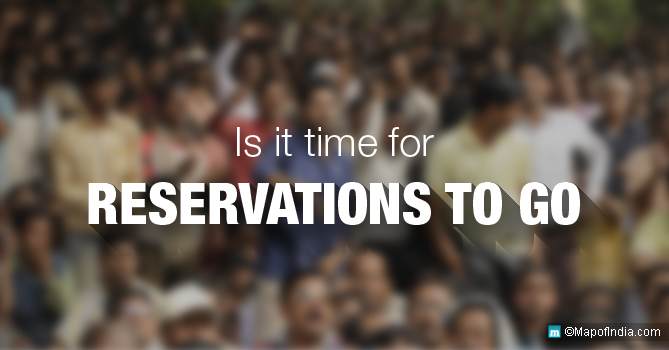Last week, I came across a marketing guru who said something simple yet very profound. “If Content is King, then Context is God”, said he. At about the same time I read an article about the now familiar lament – how brilliant students failed to make it through coveted colleges and gain a seat in their preferred courses because of the “reserved quota” seats that have been snapped up by far less (academically) accomplished students merely because the latter were born into a particular caste or follow a “minority” religion. The Reservation and the Quota system in modern India, too, is all content without any of the relevant context.
Reservation in India came in to address a context, much like the caste system itself did. The caste system meant to be an occupational division, took an ugly turn over the ages. Intermingling of classes were restricted and it lead to untouchability and other social evils and built an oppressive environment of animosity. There is no denying that social discrimination based on caste, creed, and religion continues to be one of the most inhuman and evil practices in human society.
The first introduction of reservation for the depressed classes was made in the Government of India Act of 1909 by the colonial rulers of India. It didn’t matter that they themselves added to much of the discrimination. Later, even as the British seemed to sense that their grip over India was loosening, they decided on more “positive discrimination”, now on religious lines. Muslims and Sikhs, Indian Christians and Anglo Indians, Hindus and Europeans were to all have their Quota of representation. The Dalits would have their share of reservations too.
The Need For Reservation
By the 1950s, a violent partition and mounting social divisions made it necessary to introduce reservation. Positive action and hand holding for the castes that had traditionally been kept from education, job opportunities, and growth prospects, became necessary. Between 1954 and 1978, we came up with a slew of caste and religion based quotas or reservations. A minimum of 20 percent reservation for Schedule Caste and Schedule Tribe candidates were put in place in educational institutions. Now, this was understandable but alongside were introduced two other systems which would cause much agony in the years to come – relaxation in qualifying marks for SC/ST candidates and reservation quota in public services and in employment opportunities.
Questions That Need Consideration
Now, coming back to the context factor, it’s been over seven decades that our country is independent from British administration. It’s time we step back and take a look where reservation has taken us –
- It has been at least 50 years since the Mandal Commission. The commission’s recommendations (themselves based on a 1931 census data) can hardly be relevant in modern times. It has been nearly 25 years since its recommendations were accepted and implemented. We continue to be divided in the name of caste and religion, probably because it preserves the vote banks of the political parties. There is no credible data on the number of SC, ST, OBS, minority students who get accepted into higher education institutions on the dint of merit. Isn’t it high time?
- The vote bank across the country is routinely divided into Dalits, minorities and the forward classes. How do we define “forward classes” in times like these? On the basis of economic backgrounds? Because if that were true, reservations and quotas would have long been revised to encourage students and youth from poorer sections of society rather than which caste or religion they are born into.
- How far is too far, how much is too much? The Indian Constitution allows states to come up with their own legislation for the promotion of the Scheduled Castes and the Scheduled Tribes and for other backward classes. Caste-based reservation and quotas in the state of Tamil Nadu now stands at about 69 percent allowing only 31 percent for the general category. What’s more, over 87 percent of the people in the state are considered eligible to apply under these quotas. Does this even make sense anymore?
- On the one hand we have worked for decades to do away with any form of caste discrimination. We, the people, commonly acknowledge that the very institution has outlived its relevance. But are we not strengthening the very system we seek to obliterate by reinforcing caste-based reservations? The original caste-based reservation was meant only to last for a 10 year period (review of the condition of the backward classes every ten years as suggested in 1978 was never implemented) and has only been extended in the interest of politics. The treatment of any ailment requires the administration of proper medication, but keeping on medicating a person long after he is cured shall make him sick again. So it is with reservations and the quota system.
- It is perhaps time that we look closely at our social structure and redefine “socially and economically backward classes”. Does a student who is born to affluent parents from the SC/ST/OBC category deserve the same benefits of quota reservation as others? How does economically backward not feature in the grand scheme of things as they are?
- The recent Patel agitation proves that the caste-based quota reservations have long outlived their relevance. The Patel community is a generally affluent community that faces neither social discrimination nor economic deprivation. What is the sense of entitlement that leads youth of such a community to battle for inclusion into ‘affirmative action’ then?
- Religious conversion to escape the caste-system prevalent in Hinduism is a known practice. Schedule Caste and other reserved caste candidates can, however, avail of dual benefits upon conversion. Not only do they benefit from applying for reserved seats under the minority (religion) quota, they have also been allowed to apply under the SC/ST/OBC quota. The issue was raised repeatedly at the High Court level but a proper resolution has not been found yet.
Is It Time For Reservation To Go?
Before we even attempt to answer this question with a simple Yes or a No, let us acknowledge that there is a great need to review the status of the backward classes in India. Are the economically backward classes the same set as the socially backward classes yet? How has reservation helped in the upliftment of the SC/ST, the Dalits, and the minorities in our country? Have the intended objectives of “affirmative action” been achieved? Unless we have comprehensive data and an objective authority to review the merits and the disadvantages that such reservation and relaxation in age limits and marks/achievement have brought us, we shall not be qualified to answer such a question.
One thing, however, stands out clearly. The quota and reservation system in India needs a complete overhaul. If equality is the objective, we do not have space for reservations and lax standards in the name of supporting castes and religions. The youth of India need support. Let there be more scholarships and funds, more opportunities and infrastructure for the economically backward masses. Let us make them strong enough to walk and run on their own feet, not hand them crutches to use and pass on to future generations.





